|
|
|
1981 was truly an amazing year in my life. It seems more dramatic changes occurred in this lone 12 month period than at any other time that I can recall in the last 20 years,both in my personal life as well as in the hobby of civil war reenacting.
Some time after the first of the year, my wife announced that she was pregnant. The due date was late August or early September. We were both very happy at this glorious news. We also decided that we needed a home of our own, to properly raise our little bundle of joy. I applied for a home loan using my G.I. BILL. We started looking around that winter and finally settled on a ranch style home in south Independence, Missouri. We moved into it in late February. As I was contacting all my family and friends with the exciting news of the pregnancy , I learned from Gregg Higginbotham that Steve Lillard had sold his cannon.
The rumor was, Steve liked to "Tom Cat" around. His wife apparently didn't appreciate his extra-marital activities and threatened him with divorce. I believe Steve truly loved his wife, so in an attempt to patch things up between the two of them, he sold all his Civil War stuff, and took himself out of the hobby. The First Missouri Light Artillery unit was chopped out from under us at the knees.
It would be an understatement to say I was upset. Barely in the hobby one year and it seemed that my involvement in it was over. I was an orphan without a home. Hig then told me of a recent conversation he'd had with Dick Stauffer over this very subject. It was Dick's suggestion that Hig should go ahead and start his own infantry unit right there in Kansas City. Surely in that metropolitan area, there'd be plenty of recruits available. Oh, and by the way, just go ahead and make yourself an officer. Why not! As stated in an earlier chapter, there were a number of local units throughout Missouri, who were involved in living history or other civil war related demonstrations in their own communities. When doing their own local thing, these units reverted to their local officer and NCO structure. No big deal, huh? So Hig calls me up and says I need your help in starting a unit in Kansas City. Did I want to be Corporal? (I had purchased some red artillery chevrons in anticipation of being promoted Corporal in the 1st Missouri Light Artillery, but now I would look for blue chevron's).
Hig's next question, after I agreed to help him form a new infantry unit, was which unit did we want to portray? Well, it didn't take too much of a brain cramp to settle of the 18th Missouri. Hig and I both admired the work of Dr. Leslie Anders, Professor of History at CMSU (as mentioned in my first chapter, Dr. Anders had been the author of several civil war manuscripts, articles, and two regimental histories). The next order of business was recruiting.
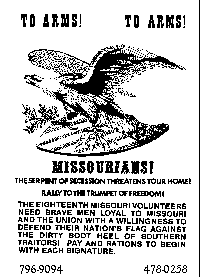 Besides working at Richards-Gebaur AFB as a fireman/EMT, Gregg Higginbotham worked part time at the Civil War Museum of Jackson County located in Lone Jack, Missouri. Lone Jack was the site of a small, but bloody fight in 1862. The original battlefield is mostly occupied by a parking lot and the museum (Hig worked behind the desk and handed out informational material on the civil war in Jackson County, sold trinkets with BATTLE OF LONE JACK on them or mostly just swept out the place). He promised to get the word out to those that visited the museum. Since I was now working full time at a print shop, it would be my task to have recruiting flyers made. I think I had about one hundred black and white flyers printed, done in the style popular during the 1860's with an eagle astride the stars and stripes. Included in the flyer was both Hig's and my phone numbers. Once done, I gave half to Hig, and distributed the rest myself. I put some in grocery store windows, tacked some to telephone poles, on bulletin boards in restaurants and laundromats, and in the local library as well. There were two gun shops in Independence, one on Truman Road and another on 24 hwy. I gave some flyers to those places as well, because they carried black powder accessories.
Besides working at Richards-Gebaur AFB as a fireman/EMT, Gregg Higginbotham worked part time at the Civil War Museum of Jackson County located in Lone Jack, Missouri. Lone Jack was the site of a small, but bloody fight in 1862. The original battlefield is mostly occupied by a parking lot and the museum (Hig worked behind the desk and handed out informational material on the civil war in Jackson County, sold trinkets with BATTLE OF LONE JACK on them or mostly just swept out the place). He promised to get the word out to those that visited the museum. Since I was now working full time at a print shop, it would be my task to have recruiting flyers made. I think I had about one hundred black and white flyers printed, done in the style popular during the 1860's with an eagle astride the stars and stripes. Included in the flyer was both Hig's and my phone numbers. Once done, I gave half to Hig, and distributed the rest myself. I put some in grocery store windows, tacked some to telephone poles, on bulletin boards in restaurants and laundromats, and in the local library as well. There were two gun shops in Independence, one on Truman Road and another on 24 hwy. I gave some flyers to those places as well, because they carried black powder accessories.
 Richard Savage had a lukewarm interest in remaining in the hobby, because he was soon to become a student of religion at a Southern Missouri Seminary. The three of us did get together briefly in Independence at the historic 1859 jail to do some living history. Now we already had a potential recruit in the form of Eric Hansen-my Prairie Grove dance partner. Plus a young fellow I met at Pilot Knob named Newton Hughes, who seemed interested in the hobby as well. Another early member of the 18th Missouri was Alan Watkins, Jim Robertson, and Frank Kirtley-a US Marine who briefly flirted with becoming a member of the dismounted cavalry. Both Bill and Davey Rumsey, from the target shooting days, had no desire what-so-ever to associate with us (they had an axe to grind over some issue with Higginbotham).
Richard Savage had a lukewarm interest in remaining in the hobby, because he was soon to become a student of religion at a Southern Missouri Seminary. The three of us did get together briefly in Independence at the historic 1859 jail to do some living history. Now we already had a potential recruit in the form of Eric Hansen-my Prairie Grove dance partner. Plus a young fellow I met at Pilot Knob named Newton Hughes, who seemed interested in the hobby as well. Another early member of the 18th Missouri was Alan Watkins, Jim Robertson, and Frank Kirtley-a US Marine who briefly flirted with becoming a member of the dismounted cavalry. Both Bill and Davey Rumsey, from the target shooting days, had no desire what-so-ever to associate with us (they had an axe to grind over some issue with Higginbotham).
An organization had been created the previous year between both Union and Confederate reenactors, called the MISSOURI CIVIL WAR REENACTORS ASSOCIATION. The MCWRA, was created in an attempt to bring reenactors, from Missouri and beyond, to at least three large events per year. These large events would be listed, in a monthly newsletter, as MAXIMUM EFFORT events in which every unit: Artillery, Cavalry, and Infantry, would be able to attend. Other MCWRA events would merely be listed and attended only if the member was interested.
The MCWRA was hosting a small event during the last weekend of March near Kansas City. It was held near Lake Jacoma at the 1855 historic village of Missouri Town. Though not actually a "town" at all, this village was created by relocating several old victorian buildings and placing them in one spot. There was a church, an inn, a dry goods store, a stable, a law office, a blacksmith shop, and several private homes.
Since this was technically a local event, and a Kansas City one at that, Gregg Higginbotham was well within his rights to dress as an officer-appearing in the dress of a 2nd Lieutenant. The newborn 18th Missouri Infantry fielded about 6 men. Dick Stauffer brought some of his 25th Missouri boys from Jeff City/Columbia and some may have come from Springfield area, but not sure. Crowley's Clay County confederates were in attendance, as well as a unit which called themselves the Lone Jack Volunteers commanded by Doug Seneker. Other "johnny rebs" I was introduced to for the first time: Pat James, Dave Ockerstrom, Randy Simmons, Dave Stauffer (no relation to Dick),and Don Pautler.
Don't recall what went on during this "seminar", as it was called, except that it rained to such a degree Saturday night that most of the boys found lodging in the barn. It seemed someone provided hot meals from an RV located in the parking lot. The highlight, or lowlight of the event, occurred Saturday afternoon. The federals were in line of battle near a tree line, separated from the "johnnies" by a field of turned earth. They were located on an island of green in this ocean of earth, and were being harassed by federal cavalry. At a particular point, as if waiting for a cue, Captain Dick insisted on a charge across this plowed field. He claimed that the "johnny" infantry had just emptied their muskets. Half way across this broken field we realized, to our regret, that only the front rank of enemy soldiers had fired. The rear rank of approximately 15 men still had loaded muskets and they quickly emptied them at us. It was like running into a brick wall. Most of company collapsed right there in the mud. The rest surrendered. Remembered with some infamy as the BATTLE OF THE PLOWED FIELD, it was probably the only time I can recall that Dickson Stauffer made a bad decision.
April 25-26 Jefferson City
One month later, the MCWRA hosted another event in Jefferson City, MO. This site was only about 100 yards NE of the capital at Historic Lohman's Landing. (Built around the 1840's, the Landing saw a lot of steamboat commerce until the coming of the railroad. Three buildings survive: The Lohman Building- a center for shipping operations and shops, the Union Hotel, and a private residence- the Christopher Maus House. All were rescued from demolition by local historians who urged and succeeded in getting the buildings restored and placed on the historic registry). The two camps were separated by Jefferson Street, which ended at the railroad tracks.
Not much went on of historical importance at this place. We had some drilling, some outdoor games, a mock political debate between Ray Ham and Doug Seneker- which nearly resulted in Ray getting "assassinated", and a mock skirmish on the lawn of the capitol. Saturday night was the first time I'd ever heard a 'sing-a-long' at a Civil War event. Led by Ray and Doug, the two camps soon pierced the night air with stirring rendition's of the most popular songs of the war. From "Bonnie Blue Flag" and "Battle Cry of Freedom", to "Kingdom Coming" and "Roll Alabama Roll". On the later song, the men sang the chorus like this:
In May, a bus trip to Champion's Hill, MS was arranged, but I found myself unable to go.
June 20-21 Grand Island, NE
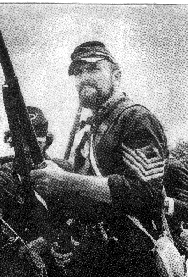 A never-ending long trip across the flatland's of Kansas to get to Nebraska, made this weekend memorable. I don't recall how I got to the event-I think we rode in Jim Robertson's van. The site was on the 200 acre Stuhr Museum of the Prairie Pioneer. A mock up of an 1880's railroad town, some log homes, several modern warehouse building's that housed THE HISTORY OF FARM MACHINERY, etc. Plus there was a working steam locomotive that ran on a track circling the park. Here I met some federals with the First Colorado: Chuck Counts, Doug Wilson, and Bob Molder. First Sergeant Molder always seemed to have a permanent scowl on his grizzled face. With the sleeves of his sack coat pushed up to his elbows, the only thing he lacked was an unlit cigar between clenched teeth. Beyond that, he was the living embodiment of the gruff old sarge from any World War II movie.
A never-ending long trip across the flatland's of Kansas to get to Nebraska, made this weekend memorable. I don't recall how I got to the event-I think we rode in Jim Robertson's van. The site was on the 200 acre Stuhr Museum of the Prairie Pioneer. A mock up of an 1880's railroad town, some log homes, several modern warehouse building's that housed THE HISTORY OF FARM MACHINERY, etc. Plus there was a working steam locomotive that ran on a track circling the park. Here I met some federals with the First Colorado: Chuck Counts, Doug Wilson, and Bob Molder. First Sergeant Molder always seemed to have a permanent scowl on his grizzled face. With the sleeves of his sack coat pushed up to his elbows, the only thing he lacked was an unlit cigar between clenched teeth. Beyond that, he was the living embodiment of the gruff old sarge from any World War II movie.
The skirmishes were of a slapstick variety. One scenario involved the train. The federals would be placed in open cars pulled by the locomotive (kind of like an amusement park ride). Then we'd get ambushed by "johnny rebs" who'd emerge from a nearby brush pile like a bunch of Jesse James' and shoot at the train. In another scenario, I was part of a small skirmish line sent ahead of my company to draw rebel fire. I was concerned with two rebs to my immediate front. Both were about 50 yards away, behind a culvert. After I fired, the both of them rose up and came at me at a dead run. I had less than 10 seconds to reload before they were upon me. Not enough time! I was taken to the ground and overpowered. One who took me down was Jim Beckner. Meanwhile, both Union and Confederate lines had been burning powder at each other for some time, until one shot fired by a rebel brought the whole Union company as if part of a KEYSTONE KOPS comedy.
I recall SHAEFFER'S beer was the beer of choice in the early '80's. Both Ray Ham and Eric Hansen had been consuming copious amounts of SHAEFFER and practicing the manual of arms drill well into the night. We found them the next morning, about two blocks from camp, dead drunk on the sidewalk. When remembering the weekend spent at Grand Island and the Stuhr Museum, I must include spending the night in the FARM MACHINERY BLDG because a tornado was in the area.
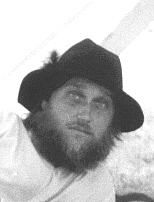
On the 4th of July, the 18th Missouri was invited to attend COLE YOUNGER DAY'S in Lee's Summit, MO. A one day festival to honor the memory of someone who rode with William Quantrill and Jesse James, this was another "dog and pony show". We were ask to help do a skit with the THREE TRAILS GANG, a cowboy-shoot-out-gang. Supposedly we federal soldiers were escorting a prisoner out of town when his cowboy buddies showed up and then bullets flew. What corn! We did have a tent set up and recruited one new guy. His name was John Maki.
Aug 1-2 Heritage Village at Hodge Park
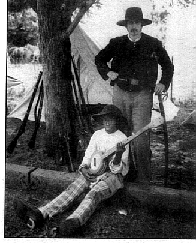 This was a recreated village near Liberty, Mo., similar to Missouri Town, in which old buildings were placed to create a community. There was the usual structure's: church, barn, private homes, etc., plus a working grist mill. A flowing stream turned a water wheel which worked a grinding stone to mill corn or wheat. My memories of Heritage Village include getting shot at in the face by a "johnny" 20 yards away. My vision remained blurred till next day. A teenage negro named Erik came out and acted as Hig's servant. Erik volunteered to do this and no one took advantage of him at all. I personally shook hands with some members of Shelby's Fifth Missouri Cavalry, who'd first ambushed us a year ago at Pilot Knob. There was Doug Sloan, Steve Allee, Scott Hughes, and Dave Bennett, just to name a few.
This was a recreated village near Liberty, Mo., similar to Missouri Town, in which old buildings were placed to create a community. There was the usual structure's: church, barn, private homes, etc., plus a working grist mill. A flowing stream turned a water wheel which worked a grinding stone to mill corn or wheat. My memories of Heritage Village include getting shot at in the face by a "johnny" 20 yards away. My vision remained blurred till next day. A teenage negro named Erik came out and acted as Hig's servant. Erik volunteered to do this and no one took advantage of him at all. I personally shook hands with some members of Shelby's Fifth Missouri Cavalry, who'd first ambushed us a year ago at Pilot Knob. There was Doug Sloan, Steve Allee, Scott Hughes, and Dave Bennett, just to name a few.
In the decade of the '80's, it seemed to me that we had a event at Heritage Village almost every other year and every year we visited the place, the federals were pushed closer and closer towards the woods until one year we were completely out of sight from the public. The federals were always outnumbered. Usually 3 to 1. Attempts were made to make the battles not so one sided by "galvanizing" some of the confederates into putting on blue jackets, but it was like pulling teeth - most didn't want to be a "stinking blue belly". In the old days, the host of the event would provide raw food to be shared equally between the two armies: potatoes, ears of corn, stew meat,etc. The rations were distributed near the reb camps and a federal detail would have to travel a good quarter mile to the distribution point. In a word, the federals usually got what was left over. Complaints were met with snickering and behind the back comments from the gray backs. I recall my days at Heritage Village with mixed emotions. There was some good times (most self-created), but after years of disrespect, the federal presence at Heritage Village became non-existent.
Aug. 16, Lone Jack,MO
This was a 2 PM ceremony at Lone Jack to honor those who fought and died at this battle. A few words were spoken, then a musket volley was fired. A monument was rededicated along with a wreath laying. Several members of the Lone Jack Volunteers and the 18th Missouri attended. We had set up a small encampment to allow visitor's to see the various gear and equipment both sides carried.
Aug 29-30, Athens, MO
I was unable to attend this event up in the extreme northeast corner of the state, because it was too close to my wife's due date. The baby could pop out any day, so the doctor told us, and I didn't want to be 200 miles away when it did. The event at Athens that weekend, was where the federal officer and NCO elections were held. Ranking positions were held for a term of one year and had to re-voted on the following year. These elections were held on the State event.
While in this meeting between all the western federals, it was decided that in the future, when we met, we would be called HOLMES BRIGADE. This was in honor of Colonel Samuel Holmes, who commanded a brigade of westerner's composed of Missouri, Illinois and Iowa units. Higginbotham was made permanent 2nd Lieutenant in the BRIGADE, and yours truly was made permanent corporal (this was all information after the fact that I heard later). Not only that, but I had also been nominated and elected as the first HOLMES BRIGADE treasurer! I was currently the 18th Missouri treasurer; a position I started earlier that year, collecting five bucks apiece from 10 guys. I'm not sure what we used the money for. Beer or beef stew, I don't recall. Now I would be responsible for collecting dues and recording the names of over 100 individuals! I had to keep a record book and open a bank account, and when called upon, give a treasurer's report. The HOLMES BRIGADE soon created their own newsletter, and I placed my report in it.
(From an article written in a February 1983 issue of the HOLMES BRIGADE DISPATCH, I reported that five dollars collected from members would be used to purchase items for the company mess: cook gear,or hard crackers from G.H.Bent. This was merely a "slush fund". No thought at the time to use money to print the newsletter or help with mailing.)
On September 11, 1981, my wife gave birth to a little girl we named Katherine Jean. Such tears of joy I shed, as I was a witness to this life brought into the world. Hig and his wife Gail came to visit us in the hospital that afternoon or the next. Gail was expecting a child also; she delivered 3 weeks later. A girl they named Hillari Meade (after George Gordon Meade-hero of Gettysburg, or so Hig claimed). I'll not bore you with too much sentimental mush. As a parent, you know what it's like to hold a beautiful gift from God in your arms that you help'd create. My life was complete.
Oct.3-4 Prairie Grove, AR: Making of THE BLUE AND THE GREY TV MOVIE
Word had gotten around that this made-for-tv-movie would be needing extras for the Battle of Bull Run scene, so a bunch of us Holmes Brigader's went (Hig's wife was in labor at this very moment, so he stayed at home). I came to the movie with John Maki. He had acquired a uniform, musket, and quite a lot of gear since the 4th of July. The two of us spent Friday and Saturday nights in his dog tent. He had a canvas front and back, plus he'd brought a buffalo blanket so we stayed fairly warm during those cold October nights.
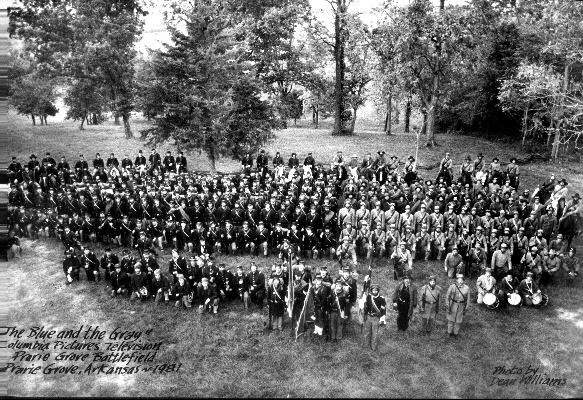
Co-starring in the movie was the 1st Colorado, the 1st Minnesota, and I don't know how many other federal units. Among all the confederates in the world, was Crowley's and the Lone Jack Volunteer's, plus Steve Lillard was back! Apparently, he'd patched things up with his wife so she let him play soldier boy again. He was in the ranks with Crowley's firing a 45-70 trap door Springfield.(At the time this photo was taken late Sunday afternoon, many reenactors had already left)
This was my first experience working with Hollywood and it was a real eye-opening one at that. I think the extras got $75 a day, plus we also got to eat in the CBS mobile cafeteria with the stars. Stacy Keach paid us a visit. This was not too long after he made that LONG RIDERS movie about the Jesse James gang. That movie was very popular at the time, especially among us Missourians, so he was well thought of and cheered when he rode his horse down to say hello. We also met Warren Oates-of WILD BUNCH fame. I think he died not long after this tv-movie was finished.
In true Hollywood fashion, we spent a lot of time idle, while shots were set up. Some of the company wags practiced bayonet drill on many of the hedge apples that grew in abundance here. There were many retakes, as either scenes were blown or angles weren't quite right. Before they used us in a scene, we had to go to makeup and get dusted with powder and/or dirt; we had to look liked we'd rolled in a hog pen. If you've seen the tv movie and looked closely, you've probably seen a lot of the soldiers, especially the confederates using the trap door Springfield muskets. They loaded much like a modern rifle, by opening the breech; inserting a round, and shutting the breech door down to lock. However, the army did not have this type of rifle until 1867. Though it was issued, it wasn't till after the Civil War and incorrect for the Battle of Bull Run which was in 1861. Oh, but what the hell! This was Hollywood. No one would notice, right?
Why do I mention this? Because one scene called for a close-up of blue coated soldiers in line of battle firing authentic Civil War muskets, so a Hollywood "piss boy" comes over to us and asks if any us had muzzle-loaders. In unison, we declared, "We all have muzzle-loaders!"
Oct.10 Mount Vernon, MO
We had a Saturday only event in this small Missouri town near Springfield, where we camped on the courthouse lawn, and recreated an event known as THE REBEL FLAG INCIDENT. From what I understand: the Confederates occupied this town until the Union boys came in. A brief skirmish was followed by the surrender of the southern host and the rebel flag was hauled from the courthouse and replaced by OLD GLORY.
Since only a one day'r, I can't recall much about what else happened. There was some festival going on in conjunction with this reenactment: Apple Butter Days or Sock Washin' Days, something. We arrived Friday night and proceeded to get 'corn'd' on SHAEFFER. Several reenactors went to a local grog shop, where one of regular bar fly's calmly asked us if we were members of the "klan". I think the locals bought us a few rounds, and it was worst drunk I'd been in over a year. The only other out-of-the-ordinary thing I recall about Mt. Vernon was someone, might have been Ray Ham, shot a cigar from his musket.
Oct 24-25, Kansas City, MO "BATTLE OF WESTPORT AT MOCKBEE FARM"
This observation of the Battle of Westport was similar to one done a year earlier at Byram's Ford Pepsi-Cola Plant. We would wait for tour buses to arrive, unload its cargo of elderly historians, then we'd 'kick-off' our little five minute battle. This year we were at Water Tower Park, property that had once belonged to a man named Mockbee.
During the October 23, 1864 fight in present day Kansas City, this part of the Union line was held by the 2nd Kansas Militia; a group of untrained farmers, blacksmiths, and schoolmasters. In their first action, the Kansans went up against the seasoned veterans under Gen. Joseph Shelby and got beat up pretty good. Those Kansans that didn't get shot or surrendered, managed to escape.
When we first arrived at the park on a Friday evening, the residents in the area apparently hadn't gotten wind to why we were there. One lady became so frightened of seeing these strange men with guns that she called the police. Several police cars and a paddy wagon did come by, but after explanations were made and neighbors reassured, the boys in blue drove away.
As evidenced by the photo, Hig was in command of the federals. Our attire, since we were portraying Militia, was a combination of civilian clothing mixed with military. It was a miserable weekend, cold, and wet. We didn't know when the tour buses would arrive, so we had to be poised and ready to jump to our places as if circus clowns under the big top. Needless to say, this was the last time a Battle of Westport Tour included an impromptu skirmish and our involvement in it.
And so 1981 drew to a close. Hig and I had started our own unit in Kansas City. We had about a dozen recruits. I had become a father and been in a movie. What an exciting year! In the next chapter, I will explain how our involvement in the Holmes Brigade caused us to end our association with the 18th Missouri and my Campaigning with Grant.